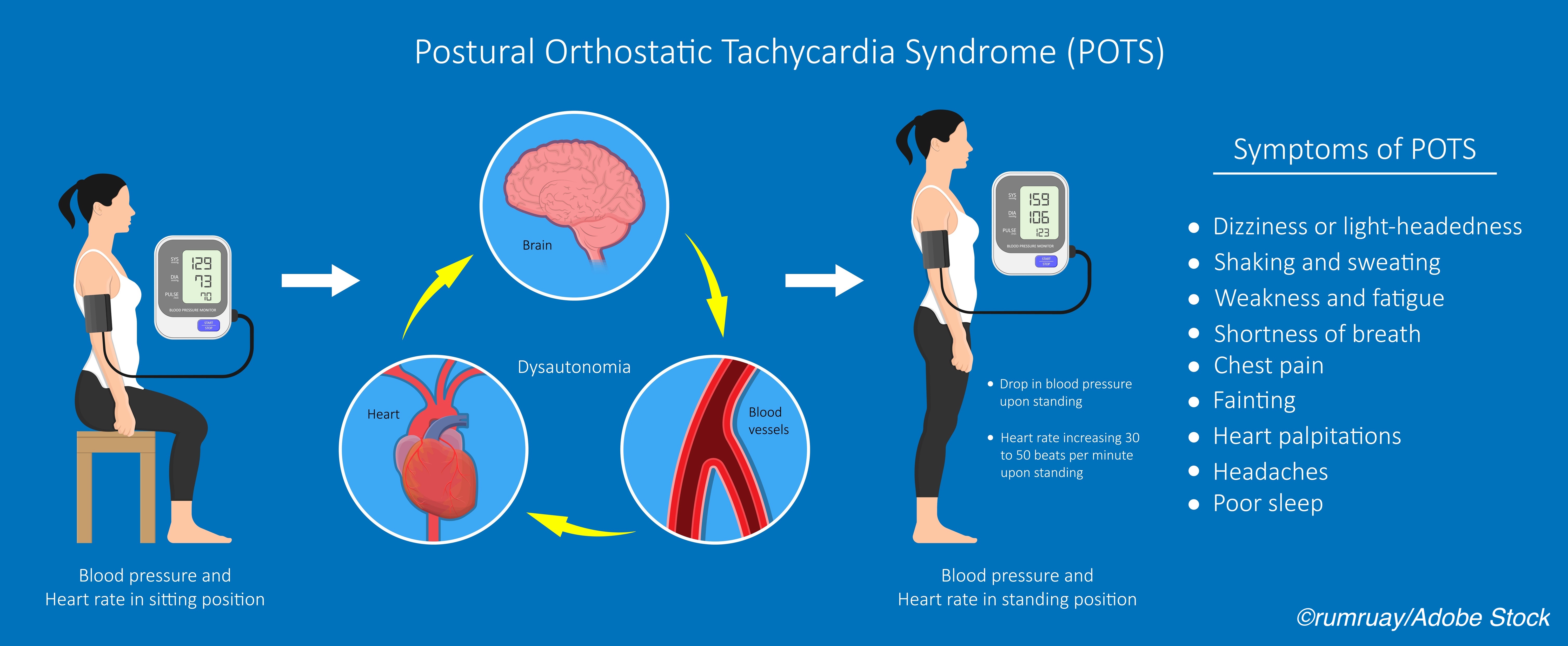The use of waist-high (abdominal and lower-body) compression reduces heart rates and improves symptoms in patients with postural orthostatic tachycardia syndrome (POTS), researchers reported.
The researchers, led by Kate M. Bourne, BSC, University of Calgary, Calgary, Alberta, Canada, found that the use of compression garments achieved these improvements in POTS patients during head-up tilt tests. Their study was published in the Journal of the America College of Cardiology.
POTS is a form of orthostatic intolerance that is characterized by a sustained heart rate (HR) increase of 30 beats/min or greater within 10 minutes of upright posture from a supine position, in the absence of a blood pressure (BP) decrease of 20/10 mm Hg, as well as the development of a group of symptoms that occurs when one stands up after reclining — such as lightheadedness, fatigue, intolerance of exercise, headache, blurry vision, palpitations, and nausea.
According to Bourne and colleagues, patients with POTS can experience a reduced quality of life comparable to that of patients with chronic obstructive pulmonary disease (COPD) and congestive heart failure.
Since there are no approved pharmacological therapies available to treat POTS, patients are managed with off-label drugs, as well as non-pharmacological therapies such as the use of compression garments. It is thought these garments work by mechanically displacing blood pooled in the abdomen and lower extremities back to the heart, which can reduce heart rates. However, the authors observed that evidence supporting their effectiveness is of low quality.
In this study, the authors evaluated the effectiveness of lower-body compression using noninflatable compression garments during head-up tilt tests (HUTS).
Thirty POTS patients between the age of 18 and 60 completed the study. The study required patients to complete four 10-minute HUTs, with 10-minute washout periods between each HUT. For each of these HUTs, participants wore either no compression garment or one of three compression garment conditions — full lower body compression, abdominal/thigh compression, and lower leg compression.
For each head-up tilt test, heart rate, beat-to-beat blood pressure, and Vanderbilt Orthostatic Symptom Score (VOSS) ratings were measured.
Bourne and colleagues found that the compression garment reduced heart rate; specifically, while no compression resulted in a heart rate of 109 beats per minute on average, lower leg compression resulted in a heart rate of 103 beats/minute, abdominal and thigh compression led to 97 beats/minute, and full abdominal and leg compression led to 92 beats/minute. Use of the compression garment also reduced symptoms, as measured by VOSS ratings.
In addition, the authors found that stroke volume (SV) and systolic blood pressure were better maintained with full abdominal and leg compression, as well as abdominal and thigh compression, compared with no compression and lower leg compression.
Of the 27 patients who completed a post-study survey, compared with no compression:
- 7% of participants said they felt “a lot better” and 41% “a little better” with lower leg compression.
- 15% felt a lot better and 37% a little better with abdominal/thigh compression.
- 56% felt a lot better and 22% felt a little better with full compression.
“In adults with POTS, a waist-high compression garment increases cardiac pre-load and SV and can ameliorate orthostatic tachycardia and associated symptoms,” Bourne and colleagues concluded.
In an editorial comment accompanying the study, David G. Benditt, MD, University of Minnesota Medical School, Minneapolis, Minnesota, and Richard Sutton, DSC, MBBS, Imperial College, Hammersmith Hospital, London, United Kingdom, noted that while the study found that external compression of the abdomen, thighs, and buttocks was useful in improving acute orthostatic tolerance in POTS patients, lower leg compression by itself was not helpful, and full coverage from feet to waist added no additional benefit beyond that provided by abdominal ad thigh compression.
“Thus, although expanding anatomic compression coverage may seem intuitively desirable, appropriate vascular bed target selection is more important,” wrote Benditt and Sutton.
However, they added, while HUT-induced heart rate change as applied in the study provides insight into vascular targets for compression therapy in POTS, “its use as a surrogate for overall symptomatic benefit must be viewed cautiously because in current conventional usage patients with POTS present a wide range of largely nonposture-related symptoms.”
-
Waist-high compression can improve symptoms in patients with postural orthostatic tachycardia syndrome (POTS).
-
Use of compression garments led to reduced heart rate in POTS patients during head-up tilt tests.
Michael Bassett, Contributing Writer, BreakingMED™
Bourne is a Vanier Scholar supported by the Canadian Institutes of Health Research.
Benditt was supported in part by a grant from the Dr. Earl E. Bakken family in support of heart-brain research.
Cat ID: 914
Topic ID: 74,914,730,914,192,925



